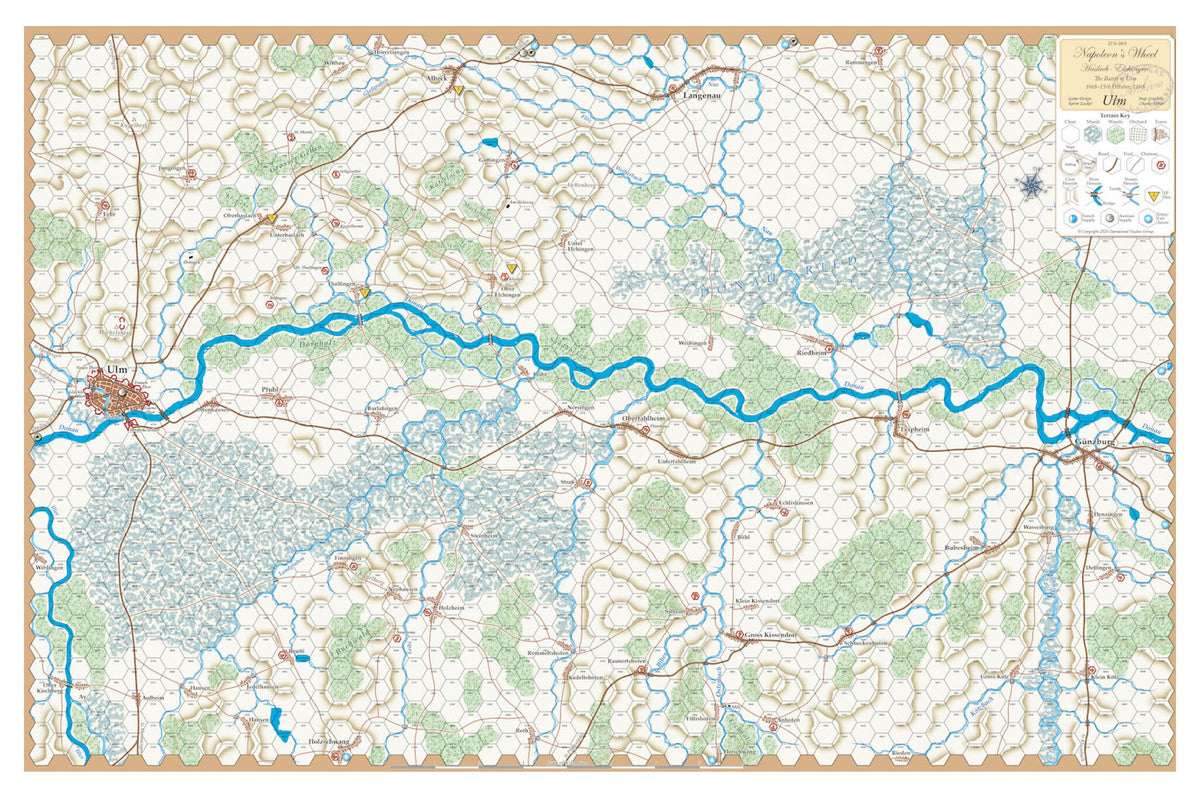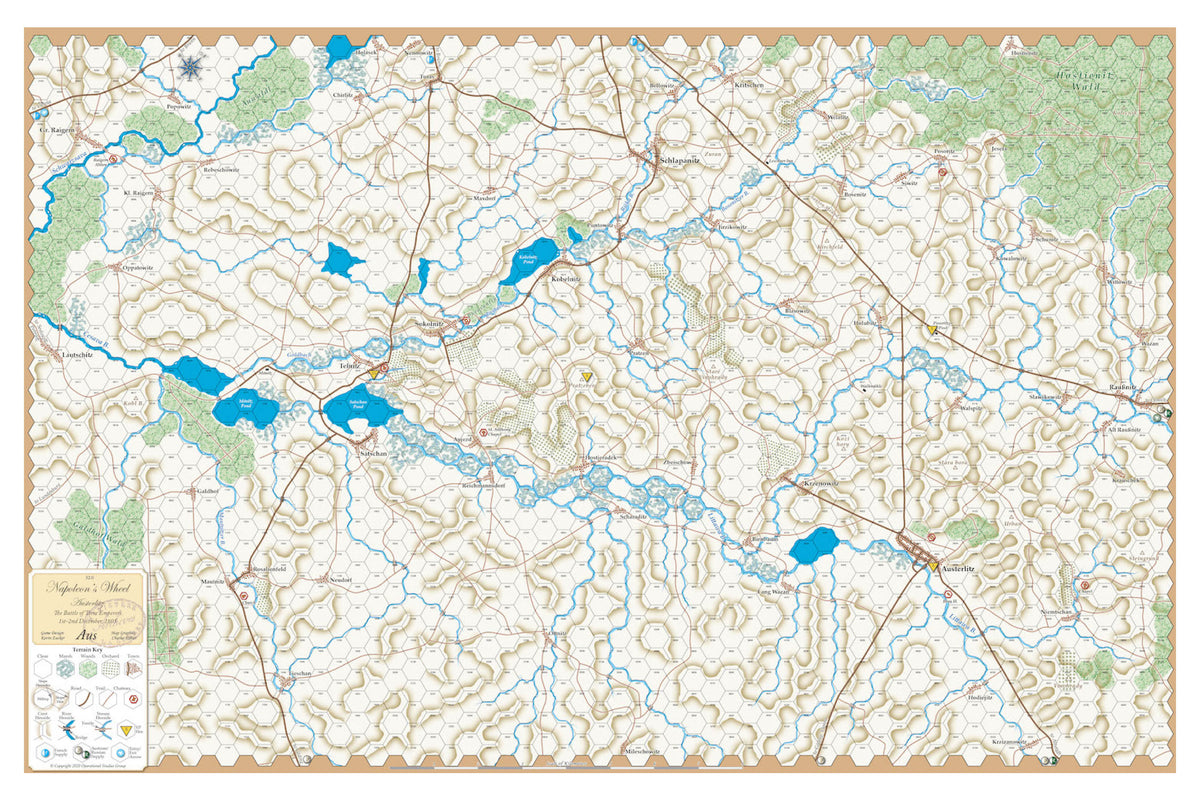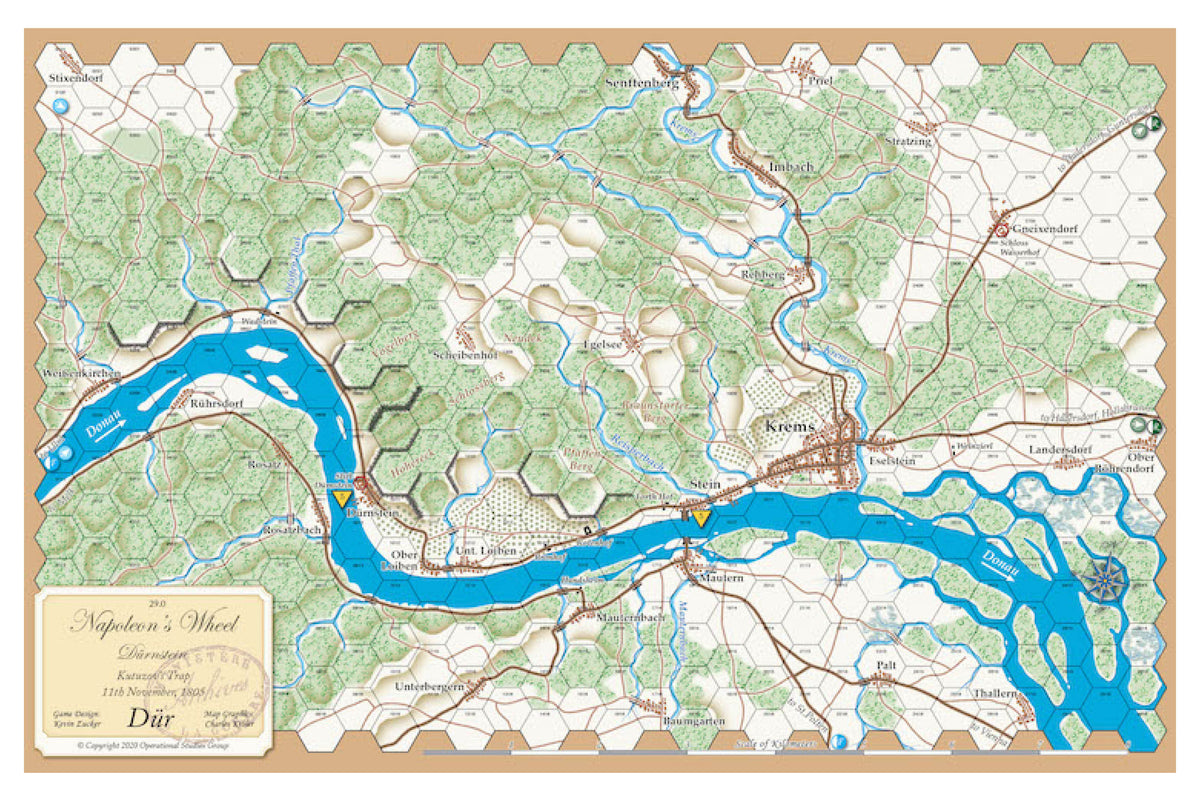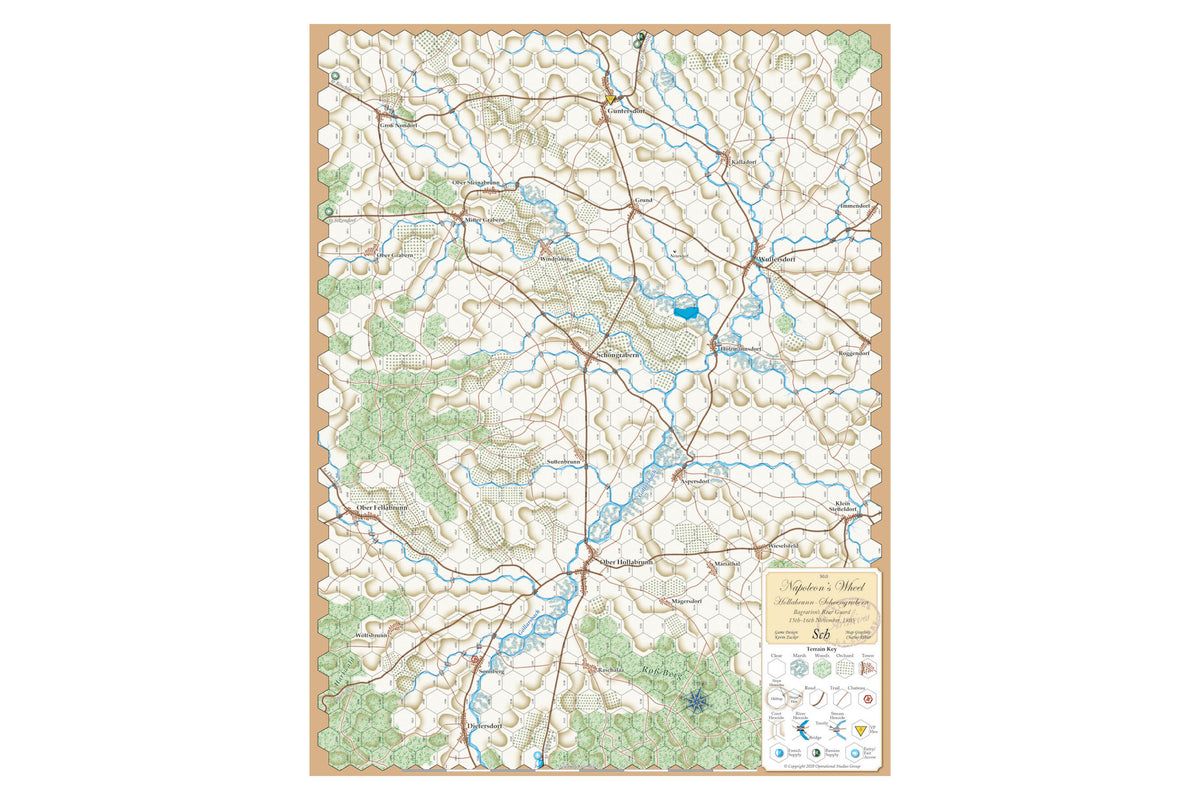
Napoleon's Wheel
Napoleon’s sudden appearance on the Danube was a shock to Austrian General Mack, who was dazzled into inactivity. In the “wheel” maneuver of October, Gunzburg, Elchingen and Ulm are all covered on one full-size map. Napoleon managed to seal off the Austrian army’s escape routes to the south and east, while Mack was fed erroneous news that revolution had broken out in France. The French captured Ulm, taking 42,000 troops at a cost of fewer than 10,000. In just 30 days they would race down the Danube and occupy Vienna.
Despite the loss of his capital, the Austrian Emperor Franz refused to surrender, retiring instead into Bohemia alongside the Russian Army under Kutuzov, meeting Tsar Alexander with a second army under Büxhowden at Olmütz.
By late November, the French were over-extended, without food and supplies. When the Austro-Russian army advanced en masse to the hills west of Austerlitz, Napoleon played along, ordering his troops to feign demoralization and a panicked retreat.
Battles Simulated
Ulm, Napoleon’s Wheel, 9-15 October
General Mack’s plan was to attack across the Danube at Napoleon’s exposed lines of communication. He had concentrated his forces at Ulm for this purpose and ordered Kienmayer to move towards him to support the attack.
Mack wasn’t wrong about the strategic value of Ulm. He assumed that this conferred on him a strategic victory in the old 18th century book of strategic thinking. From this point he would be able to maneuver in any direction, without being cut off from supplies, etc. The deep flaw in his thinking was revealed by Napoleon’s Wheel around Ulm. In the 18th century such a move would not have been possible. There was no operational level to their thinking in those days. What had changed was a new network of post roads. The Battles of Gunzburg, Elchingen, and Ulm are all covered on one of the two full-size maps.
Napoleon managed to seal off the Austrian army’s escape routes to the south and east, while Mack was fed erroneous news that revolution had broken out in France. Mack sent Reisch down the left bank of the Danube toward Donauwörth. Ney crossed to the north bank of the Danube and attacked Riesch’s corps at Elchingen. The French captured the heights and drove the Austrians west toward Ulm, taking many prisoners. Although Austrian light troops remained on the north bank, Mack’s army would soon be surrounded.
Image: Napoleon ordering the II Corps into action.


Dürrenstein, Kutuzov’s Trap, 11 Nov.
Mortier had over-extended his three divisions along the north bank of the Danube. Mikhail Kutuzov, commander of the Coalition Army, enticed Mortier to send Gazan’s division into a trap and French troops were caught in a valley between two Russian columns. They were rescued by the timely arrival of Dupont’s division. Both sides claimed victory. The French lost more than a third of their participants, and Gazan’s division lost over 40 percent.
Image: Marshal Mortier at the battle of Durenstein in 1805.
Schoengraben, Bagration’s Rear- Guard, 16 November
Bagration was assigned the role of rear-guard to provide the retreating Coalition Army some elbow-room. In the evening, Oudinot’s grenadiers attacked and carried the village. Oudinot (pictured to the right) was wounded and lost 2,000 men. Bagration lost 2,400, but withdrew in good order.
Image: Marshal Nicolas Oudinot


Austerlitz, The Battle of Pratzen and Sokolnitz, 1-2 Dec.
The Austro- Russians occupied the Pratzen Heights, the dominating feature of the battlefield. Their plan required a flank march in the presence of the enemy. Napoleon’s deliberately-weakened right was a tempting target and, at the outset, the attack had the French on the ropes. A weak division under Davout arrived in time to check the enemy for the remainder of the day in a terrible struggle at Sokolnitz. As the Russians marched off the plateau to reinforce the south, Napoleon unleashed the IV Corps into their vacated center. Miloradovich attempted to plug the gap, and the battle entered its critical phase. The Russian left wing under Buxhöwden was driven back upon the lakes and decimated. The Austro-Russians lost about 26,000 men and 191 guns; the French about 8,000 men.
Image: Painting of the Battle of Austerlitz by François Gérard
game components
napoleon's wheel
Each game includes:
Game Box
2 Maps 34"x22"
1 Map 22"x17"
1 Map 17"x11"
2 Counter Sheets (560 die-cut player pieces)
2 Booklets (System Rules and Study Folder)
20 Player Aid Cards (TRC x 8, Casualty x 2, Setup x 5, Fog of War x 2, Weather, Reorganization, Combat)
5 Resource Cards (Booklet of Card Instructions, Combat Tables Folder, Sequence of Play, Victory Worksheet).
2 Card Decks (50 cards each)
Visit our Game Components section for details

Game Unboxing
Napoleon's Wheel
game maps
napoleon's wheel, danube campaign part I
Each game includes four high quality maps (shown below): two 17"x22" maps and two 22"x34" maps.
Operational Studies Group (OSG) is a leader in the design and production of Napoleonic Wargames. Our maps are extensively researched, historically accurate, and printed on heavy cardstock in full color.

PLAYER RESOURCES
CLICK PDF FILE TO DOWNLOAD
• Napoleon Wheel's Update 20FEB22
• Napoleon's Wheel Study 1.72
• Battle of Austerlitz AtB Coalition Setup v1.02
• Battle of Austerlitz AtB French Setup v1.01
• Battle of Austerlitz DoB Coalition Setup v1.02
• Battle of Austerlitz DoB French Setup v1.01
• Battle of Durnstein French & Coalition Setup v1.01
• Battle of Elchingen AtB Coalition Setup v1.01
• Battle of Elchingen AtB French Setup v1.02
• Battle of Elchingen DoB Coalition Setup v1.01
• Battle of Elchingen DoB French Setup v1.01
• Battle of Haslach French & Coalition Setup v1.01
• Battle of Hollabrunn AtB French & Coalition Setup
• Battle of Schoengrabern DoB French & Coalition Setup v1.01
• Battle of Austerlitz AtB Coalition v1.02
• Battle of Austerlitz AtB French v1.01








